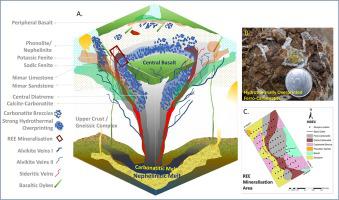Ore Geology Reviews ( IF 3.2 ) Pub Date : 2021-05-06 , DOI: 10.1016/j.oregeorev.2021.104215 Prashant Dhote , Uday Bhan , Dhananjay Verma

|
Carbonatites and associated alkaline rocks are the primary sources for REE mineralization. The Ambadongar Carbonatite Complex (ADCC) from NW Deccan Volcanic Province (DVP) constitutes the largest Carbonatite Associated REE Deposits (CARD) in India. ADCC belongs to the final stages of the Late Cretaceous alkaline-carbonatite magmatism associated with main Deccan basalt volcanic activity. The ADCC is an envisioned diatreme structure in which four carbonatitic phases are recognized, mainly calcio-carbonatites and ferro-carbonatites. Each successive carbonatite phase shows higher REE enrichment. The primary REE mineralization with bastnäsite as the dominant REE phase is hosted by pervasive hydrothermally altered ferro-carbonatite plugs. The secondary mineralogy formed with barites in the main orebody during late- to post-magmatic hydrothermal fluid alteration is fluorite, quartz, ankerite, and other REE-bearing minerals like bastnäsite, parisite, synchysite, strontianite, florencite, monazite and columbite.
Carbonatite samples contain 18.61% to 52.42% of CaO, and the LOI varies from 5.28% to 38.79%. Most can be classified as calcio-carbonatites. Since all the samples also contain an appreciable amount of Fe2O3 (4.13% to 20.20%) and MnO (0.07% to 5.46%), some may be classified as ferro-carbonatites. Total REE content varies from 0.6 to 4%, with a high Ce concentration and LREE/HREE ratio. The highest values for La, Ce, Pr, and Nd are 1.95%, 1.56%, 0.16%, and 0.45%, respectively.
Metasomatism of SCLM from asthenospheric melts followed by the low degree partial melting of the SCLM region is responsible for fertile carbonatite generation in ADCC. The multiphase liquid immiscibility of carbonatite melts from carbonate-silicate magma followed by immiscibility of REE rich carbonatite melt and REE deficient fluoride-rich aqueous fluids explain the higher level of REE enrichment in each successive phases of carbonatites in ADCC.
The mineralizing fluids were probably the result of residual magmatic volatiles that brought mainly REE and later SiO2 into the overprinted rocks. Ambadongar carbonatites' stable isotopic compositions agree with a magmatic origin (δ13C = −4.1 ± 1.9‰ [PDB] and δl8O = 10.3 ± 1.7‰ [SMOW]). The C–O stable isotopic modeling indicates re-equilibration under hydrothermal conditions between 180 °C and 70 °C. Significant amounts of REE fluorocarbonate minerals, relatively Sr- and Th-rich, were deposited during re-equilibration. The REE fluorocarbonate bastnäsite-(Ce) occurs as late individual crystals, overgrown on the synchysite and parisite polycrystals. Textural and chemical reactions between the REE fluorocarbonates provide insights into rare-earth elements' mobility during fluid-rock interaction. Early crystallization of synchysite/parisite indicates the high activity of Ca2+, OH−, (SO4)2−, Al and Si in the fluid. Later, the fluid was characterized by increased activity of F−, (SO4)2−, REE and Si, and decreased activity of Ca2+ as reflected in the association of barite, fluorite, quartz, and bastnäsite typical of strongly overprinted ferro-carbonatites.
Re-equilibration and recrystallization of the primary minerals in the presence of OH−, (SO4)2−, F−, REE, Al, and Si carried in solution by the hydrothermal fluid is the leading cause behind the refixing of REE in the form of REE fluorocarbonate in REE rich ferro-carbonatites.
中文翻译:

印度德干火山省安巴东加尔碳酸盐岩综合体中碳酸盐岩型稀土元素成矿的成因模型
碳酸盐岩和相关的碱性岩石是稀土元素矿化的主要来源。来自西北德肯火山省(DVP)的Ambadongar碳酸盐岩联合体(ADCC)构成了印度最大的碳酸盐岩伴生稀土矿(CARD)。ADCC属于与主要Deccan玄武岩火山活动有关的白垩纪晚期碱性碳酸盐岩岩浆作用的最后阶段。ADCC是一种预想的非晶体结构,其中识别出四个碳酸盐相,主要是钙碳质碳酸盐岩和铁碳质碳酸盐岩。每个相继的碳酸盐相都显示出较高的REE富集。以普氏体为主要REE相的主要REE矿化作用是由普遍的热液蚀变的铁碳酸盐岩屑岩引起的。
碳酸钙样品包含18.61%至52.42%的CaO,LOI在5.28%至38.79%之间。大多数可以归为钙碳酸盐。由于所有样品还包含相当数量的Fe 2 O 3(4.13%至20.20%)和MnO(0.07%至5.46%),因此有些样品可以归为铁碳酸盐岩。稀土元素的总含量从0.6%到4%不等,铈含量高且LREE / HREE比高。La,Ce,Pr和Nd的最高值分别为1.95%,1.56%,0.16%和0.45%。
来自软流圈熔体的SCLM交代作用,接着SCLM区域的低度部分熔解是ADCC中可生碳酸盐生成的原因。碳酸盐-硅酸盐岩浆中碳酸盐岩熔体的多相液体不溶性,然后是富含REE的碳酸盐熔体和缺乏REE的富含氟的水流体的不溶混性,说明了ADCC中碳酸盐岩的每个连续相中较高的REE富集度。
矿化流体可能是残留岩浆挥发物的结果,这些岩浆挥发物主要将REE和后来的SiO 2带入叠印的岩石中。Ambadongar碳酸稳定同位素组成同意岩浆原点(δ 13 C = -4.1±1.9‰[PDB]和δ L8O = 10.3±1.7‰[SMOW])。C–O稳定同位素模型表明在180°C至70°C的水热条件下会重新平衡。在重新平衡过程中,沉积了大量富含Sr和Th的REE氟碳酸盐矿物。REE碳氟化合物的bastnäsite-(Ce)以晚单个晶体的形式出现,在长生多生和多生多生多晶上过度生长。REE碳氟化合物之间的结构和化学反应可提供有关流体与岩石相互作用过程中稀土元素迁移率的见解。杂合体/杂合体的早期结晶表明,流体中Ca 2 +,OH -,(SO 4)2-,Al和Si具有较高的活性。后来,流体的特点是增加的F活动-,(SO 4)2−,稀土元素和硅,以及Ca 2+的活性降低,这反映在重叠印铁碳酸盐岩典型的重晶石,萤石,石英和辉石的结合中。
再平衡和原生矿物的再结晶中OH的存在- ,(SO 4)2-,F - ,稀土元素,Al和Si中的溶液通过水热流体携带是稀土元素中的refixing背后的主要原因富含铁的碳酸盐岩中的稀土碳酸盐形式。











































 京公网安备 11010802027423号
京公网安备 11010802027423号